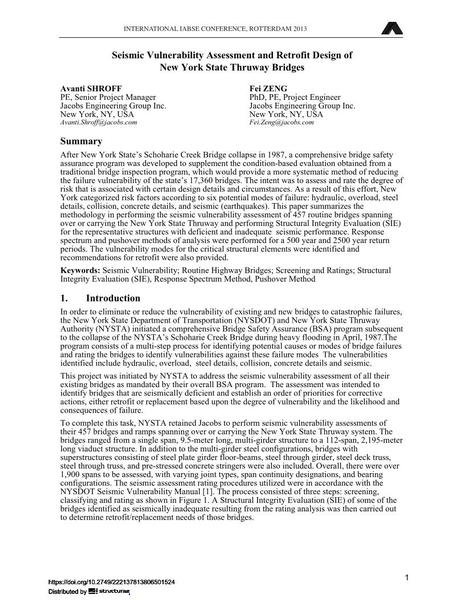Seismic Vulnerability Assessment and Retrofit Design of New York State Thruway Bridges

|
|
|||||||||||
Bibliographic Details
| Author(s): |
Avanti Shroff
Fei Zeng |
||||
|---|---|---|---|---|---|
| Medium: | conference paper | ||||
| Language(s): | English | ||||
| Conference: | IABSE Conference: Assessment, Upgrading and Refurbishment of Infrastructures, Rotterdam, The Netherlands, 6-8 May 2013 | ||||
| Published in: | IABSE Conference, Rotterdam, May 2013 | ||||
|
|||||
| Page(s): | 340-341 | ||||
| Total no. of pages: | 8 | ||||
| Year: | 2013 | ||||
| DOI: | 10.2749/222137813806501524 | ||||
| Abstract: |
After New York State’s Schoharie Creek Bridge collapse in 1987, a comprehensive bridge safety assurance program was developed to supplement the condition-based evaluation obtained from a traditional bridge inspection program, which would provide a more systematic method of reducing the failure vulnerability of the state’s 17,360 bridges. The intent was to assess and rate the degree of risk that is associated with certain design details and circumstances. As a result of this effort, New York categorized risk factors according to six potential modes of failure: hydraulic, overload, steel details, collision, concrete details, and seismic (earthquakes). This paper summarizes the methodology in performing the seismic vulnerability assessment of 457 routine bridges spanning over or carrying the New York State Thruway and performing Structural Integrity Evaluation (SIE) for the representative structures with deficient and inadequate seismic performance. Response spectrum and pushover methods of analysis were performed for a 500 year and 2500 year return periods. The vulnerability modes for the critical structural elements were identified and recommendations for retrofit were also provided. |
||||
| Keywords: |
seismic vulnerability response spectrum method Routine Highway Bridges Screening and Ratings Structural Integrity Evaluation (SIE) Pushover Method
|
||||
